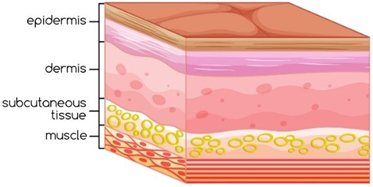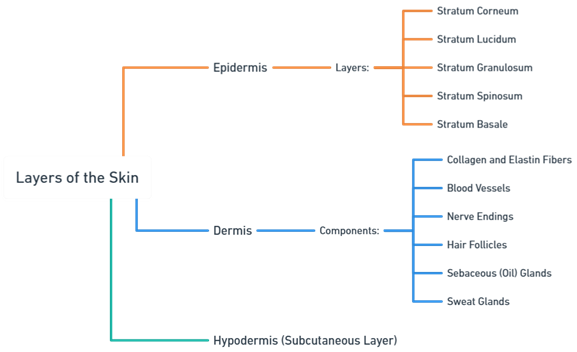- The Structure of skin is the largest organ of the body and serves multiple essential functions.
- It is composed of three main layers, each with distinct structures and roles.
Epidermis:
- The outermost layer of the skin, composed mainly of keratinocytes, which produce the protein keratin.
Layers of the Epidermis:
- Stratum Corneum: The topmost layer, made of dead, flattened keratinocytes that provide a tough, protective barrier.
- Stratum Lucidum: A thin, clear layer found only in thick skin areas like the palms and soles.
- Stratum Granulosum: Where keratinocytes begin to die and form a waterproof barrier.
- Stratum Spinosum: Provides strength and flexibility to the skin.
- Stratum Basale: The deepest layer, where new skin cells are produced. It also contains melanocytes, which produce melanin for skin color and UV protection.
Dermis in structure of skin:
- Located beneath the epidermis, the dermis is thicker and composed of connective tissue, blood vessels, nerves, and various appendages.
Components:
- Collagen and Elastin Fibers: Provide strength, elasticity, and structural support.
- Blood Vessels: Supply nutrients and oxygen to the skin and help regulate temperature.
- Nerve Endings: Detect sensations like touch, pressure, temperature, and pain.
- Hair Follicles: Structures from which hair grows.
- Sebaceous (Oil) Glands: Produce sebum, which moisturizes and protects the skin.
- Sweat Glands: Produce sweat for temperature regulation.
Hypodermis (Subcutaneous Layer):
- The deepest layer, primarily made of fat and connective tissue.
- Function: Provides insulation, stores energy, and acts as a cushion to protect underlying muscles and organs. Top of Form Bottom of Form
Click Here to Watch the Best Pharma Videos


